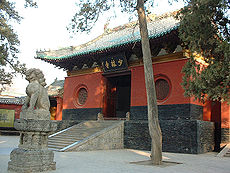- Dong Haichuan
-
 Dong Haichuan
Dong Haichuan
Part of the series on
Chinese martial artsList of Chinese martial arts Terms Historical places - Shaolin Monastery (少林寺)
- Wudang Mountains (武當山)
- Mount Hua (華山)
- Mount Emei (峨嵋山)
- Kunlun Mountains (崑崙山)
Historical people - Five Elders (五祖)
- Yim Wing-chun / Yan Yongchun (嚴詠春)
- Hung Hei-gun / Hong Xiguan (洪熙官)
- Fong Sai-yuk / Fang Shiyu (方世玉)
- Dong Haichuan (董海川)
- Yang Lu-ch'an (楊露禪)
- Wu Quanyou (吳全佑)
- Ten Tigers of Canton (廣東十虎)
- Chen Fake (陳發科)
- Chan Heung / Chen Xiang (陳享)
- Wong Fei-hung / Huang Feihong (黃飛鴻)
- Sun Lu-t'ang (孫祿堂)
- Huo Yuanjia (霍元甲)
- Yip Man / Ye Wen (葉問)
- Wang Zi-Ping (王子平)
- Bruce Lee / Li Xiaolong (李小龍)
- Jackie Chan / Cheng Long (成龍)
- Sammo Hung / Hong Jinbao (洪金寶)
- Yuen Biao / Yuán Biāo (元彪)
- Jet Li / Li Lian Jie (李連杰)
- Donnie Yen / Zhēn Zǐdān (甄子丹)
Legendary figures - Bodhidharma / Putidamo / Damo (菩提達摩)
- Zhang Sanfeng (張三丰)
- Eight immortals (八仙)
Related Dong Haichuan (Chinese: 董海川; pinyin: Dǒng Hǎichuān) was born on the 13th of October 1797 (or 1813) in Zhu village, Ju Jia Wu Township, Wen'an County, Hebei Province, China and died on the 25th of October 1882 in Beijing. He is regarded as a skillful martial artist and is widely credited to be the founder of Baguazhang[1]. Most, if not all, existing schools of Baguazhang place Dong Haichuan at the beginning of their lineage.
Contents
Biography
As a child and young man he intensely trained in the martial arts of his village. The arts were probably Shaolin-based and may have included Bafanshan (a possible precursor to Fanziquan), Hongquan, Xingmenquan, and Jingangquan. These were the arts being taught in and around Dong’s village at this time[2]. Alternatively, Dong is sometimes said to have learned and practiced Erlangquan, Luohanquan, or other arts.
His family is thought to have been so poor, at some point around 1853, Dong left Hebei Province to seek work elsewhere. By many accounts he is described as spending his youth travelling, penniless, and often getting in trouble. But he, even by his own claims, continued to study martial arts intensely during his travels. Where, by whom, and what he was taught, varies depending on the source. But it is generally accepted that, during this time, Dong studied Taoist training methods that included some kind of circle walking practice. He synthesized his previous experience with his village arts, what he had learned in his travels, and his Taoist studies to create a unique art originally called Zhuanzhang (Turning Palms). Zhuanzhang in later years became called Baguazhang.
Around 1864 Dong arrived in Beijing and was hired as a servant at the residence of the Prince Su. Later Prince Su gave him the job of tax collector. Dong and his top student Yin Fu went to Mongolia to collect taxes, where he spent ten years. Upon his return he left the prince's employ and began to teach publicly, giving up all other occupations to fully devote himself to developing and teaching Baguazhang.
The nature of what he taught is generally disputed. Some believe that he consistently taught only the first three of eight palms (Single Change Palm, Double Change Palm and Smooth Body Palm) and that he would vary the last five depending on the individuals’ previous martial arts experience. Others believe that he taught considerably more material. It was also in his public teaching period that the art was given the name Baguazhang (Eight tri-gram palm). Baguazhang became popular in Beijing and surrounding areas [3].
In his later years he was poor and lived with Yin Fu's student Ma Gui. Ma owned a lumber yard and Dong lived on the premises. He died in 1882.
By the late 19th century, Baguazhang had become a well-known fighting style in Beijing and northern China, and Dong Haichuan and his students became famous. This gave rise to many fictitious stories and written pulp novels which were adopted as fact.
Students
Dong taught Baguazhang to several highly regarded martial artists, notably Yin Fu, Ma Gui and Cheng Tinghua. Their names are recorded at his grave [4].
See also
References
- ^ Nine Dragon Baguazhang
- ^ Pa Kwa Chang Journal 3 (1). http://pakuachangjournal.com.
- ^ Cardinal. "Baguazhang, Eight-Diagram Palms Shadow Boxing". Sonshi. http://www.sonshi.com/baguazhang.html.
- ^ Ottawa Chinese Martial Arts
Bibliography
- Smith, Robert W. "Chinese Boxing", ISBN 1-55643-085-X
- Liang, Shou-Yu; Yang, Jwing-Ming; Wu, Wen-Ching "Baguazhang : Emei Baguazhang Theory and Applications", pp 36–38, ISBN 0-940871-30-0
- Smith, Robert W.; Pittman, Allen "Pa-Kua - Eight Trigram Boxing" pp 19–22, ISBN 0-8048-1618-2
External links
- The Yin and Yang of Ba Gua Zhang: The Legends of Thin Yin and Spectacles Cheng by Frank Allen & Clarence Lu
Categories:- 1797 births
- 1882 deaths
- Chinese baguazhang practitioners
- Chinese martial artists
- I Ching
- Martial arts school founders
- People from Langfang
- Qing Dynasty Taoists
Wikimedia Foundation. 2010.

